关联关系
在关联型数据库中,表与表之间很少是独立与其他表妹关系的。所以在实际开发过程中我们会碰到很多复杂的关联关系。
1 对 1 关系
我们有一张员工表(t_emp),一张部门表(t_dept)。员工表中的一条记录对应于部门表中有且仅有一条记录。这就是一对一的关联关系

映射文件
<?xml version="1.0" encoding="UTF-8"?>
<!DOCTYPE mapper
PUBLIC "-//mybatis.org//DTD Mapper 3.0//EN"
"http://mybatis.org/dtd/mybatis-3-mapper.dtd">
<mapper namespace="com.sxt.dao.EmpDao">
<resultMap type="Emp" id="baseResultMap">
<!-- 主表里面的信息 -->
<id column="empId" property="empId"/>
<result column="empName" property="empName"/>
<result column="sex" property="sex"/>
<!-- 配置1对1的关联关系 property 对应的就是Emp中部门成员变量的名称-->
<association property="dept" javaType="Dept">
<id column="deptId" property="deptId"/>
<result column="deptName" property="deptName"/>
<result column="deptDesc" property="deptDesc"/>
</association>
</resultMap>
<select id="query" resultMap="baseResultMap">
select
t1.empId
,t1.empName
,t1.sex
,t2.deptId
,t2.deptName
,t2.deptDesc
from t_emp t1
LEFT JOIN
t_dept t2
ON t1.deptId = t2.deptId
</select>
</mapper>
员工类
package com.sxt.pojo;
public class Emp {
private Integer empId;
private String empName;
private String sex;
//private Integer deptId;
//员工和部门的关联关系是1VS1
private Dept dept;
public Integer getEmpId() {
return empId;
}
public void setEmpId(Integer empId) {
this.empId = empId;
}
public String getEmpName() {
return empName;
}
public void setEmpName(String empName) {
this.empName = empName;
}
public String getSex() {
return sex;
}
public void setSex(String sex) {
this.sex = sex;
}
public Dept getDept() {
return dept;
}
public void setDept(Dept dept) {
this.dept = dept;
}
@Override
public String toString() {
return "Emp [empId=" + empId + ", empName=" + empName + ", sex=" + sex + ", dept=" + dept + "]";
}
}
部门类
package com.sxt.pojo;
public class Dept {
private Integer deptId;
private String deptName;
private String deptDesc;
//部门和员工的关系是 1 VS N 一对多
public Integer getDeptId() {
return deptId;
}
public void setDeptId(Integer deptId) {
this.deptId = deptId;
}
public String getDeptName() {
return deptName;
}
public void setDeptName(String deptName) {
this.deptName = deptName;
}
public String getDeptDesc() {
return deptDesc;
}
public void setDeptDesc(String deptDesc) {
this.deptDesc = deptDesc;
}
@Override
public String toString() {
return "Dept [deptId=" + deptId + ", deptName=" + deptName + ", deptDesc=" + deptDesc + "]";
}
}
接口
package com.sxt.dao;
import java.util.List;
import com.sxt.pojo.Emp;
public interface EmpDao {
public List<Emp> query();
}
测试
package com.sxt.test;
import java.io.IOException;
import java.io.InputStream;
import java.util.List;
import org.apache.ibatis.io.Resources;
import org.apache.ibatis.session.SqlSession;
import org.apache.ibatis.session.SqlSessionFactory;
import org.apache.ibatis.session.SqlSessionFactoryBuilder;
import org.junit.After;
import org.junit.Before;
import org.junit.Test;
import com.sxt.dao.EmpDao;
import com.sxt.pojo.Emp;
public class TestDemo {
private SqlSession session;
@Before
public void before() throws IOException{
InputStream in = Resources.getResourceAsStream("mybatis-config.xml");
SqlSessionFactory factory = new SqlSessionFactoryBuilder().build(in);
session = factory.openSession();
}
@Test
public void test1() throws IOException {
EmpDao dao = session.getMapper(EmpDao.class);
List<Emp> list = dao.query();
for (Emp emp : list) {
System.out.println(emp);
}
}
@After
public void after(){
session.commit();
session.close();
}
}

一对多
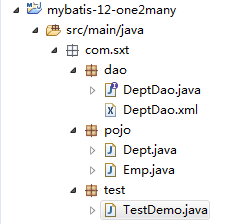
查询出所有的部门信息及该部门下所有员工的信息
映射文件
<?xml version="1.0" encoding="UTF-8"?>
<!DOCTYPE mapper
PUBLIC "-//mybatis.org//DTD Mapper 3.0//EN"
"http://mybatis.org/dtd/mybatis-3-mapper.dtd">
<mapper namespace="com.sxt.dao.DeptDao">
<resultMap type="Dept" id="baseResultMap">
<!-- 主表里面的信息 -->
<id column="deptId" property="deptId"/>
<result column="deptName" property="deptName"/>
<result column="deptDesc" property="deptDesc"/>
<!-- 配置1对多的关联关系 ofType就是集合中泛型的类型-->
<collection property="emps" ofType="Emp">
<id column="empId" property="empId"/>
<result column="empName" property="empName"/>
<result column="sex" property="sex"/>
</collection>
</resultMap>
<select id="query" resultMap="baseResultMap">
select
t1.deptId
,t1.deptName
,t1.deptDesc
,t2.empId
,t2.empName
,t2.sex
from t_dept t1
LEFT JOIN
t_emp t2
ON t1.deptId = t2.deptId
</select>
</mapper>
对象与对象一对多
Emp类
package com.sxt.pojo;
public class Emp {
private Integer empId;
private String empName;
private String sex;
//private Integer deptId;
public Integer getEmpId() {
return empId;
}
public void setEmpId(Integer empId) {
this.empId = empId;
}
public String getEmpName() {
return empName;
}
public void setEmpName(String empName) {
this.empName = empName;
}
public String getSex() {
return sex;
}
public void setSex(String sex) {
this.sex = sex;
}
@Override
public String toString() {
return "Emp [empId=" + empId + ", empName=" + empName + ", sex=" + sex + "]";
}
}
Dept类
package com.sxt.pojo;
import java.util.List;
public class Dept {
private Integer deptId;
private String deptName;
private String deptDesc;
//部门和员工的关系是 1 VS N 一对多
private List<Emp> emps;
public Integer getDeptId() {
return deptId;
}
public void setDeptId(Integer deptId) {
this.deptId = deptId;
}
public String getDeptName() {
return deptName;
}
public void setDeptName(String deptName) {
this.deptName = deptName;
}
public String getDeptDesc() {
return deptDesc;
}
public void setDeptDesc(String deptDesc) {
this.deptDesc = deptDesc;
}
public List<Emp> getEmps() {
return emps;
}
public void setEmps(List<Emp> emps) {
this.emps = emps;
}
@Override
public String toString() {
return "Dept [deptId=" + deptId + ", deptName=" + deptName + ", deptDesc=" + deptDesc + ", emps=" + emps + "]";
}
}
接口
package com.sxt.dao;
import java.util.List;
import com.sxt.pojo.Dept;
public interface DeptDao {
public List<Dept> query();
}
测试
package com.sxt.test;
import java.io.IOException;
import java.io.InputStream;
import java.util.List;
import org.apache.ibatis.io.Resources;
import org.apache.ibatis.session.SqlSession;
import org.apache.ibatis.session.SqlSessionFactory;
import org.apache.ibatis.session.SqlSessionFactoryBuilder;
import org.junit.After;
import org.junit.Before;
import org.junit.Test;
import com.sxt.dao.DeptDao;
import com.sxt.pojo.Dept;
public class TestDemo {
private SqlSession session;
@Before
public void before() throws IOException{
InputStream in = Resources.getResourceAsStream("mybatis-config.xml");
SqlSessionFactory factory = new SqlSessionFactoryBuilder().build(in);
session = factory.openSession();
}
@Test
public void test1() throws IOException {
DeptDao dao = session.getMapper(DeptDao.class);
List<Dept> list = dao.query();
for (Dept dept : list) {
System.out.println(dept);
System.out.println(dept.getEmps());
}
}
@After
public void after(){
session.commit();
session.close();
}
}
一个部门多个员工

延迟加载
延迟查询的一对一和一对多查询的延续
在默认的一对一和一对多中,一条SQL就能查询到所有数据,但是,有的数据有时候一时半会用不上,例如查询员工,捎带获取员工的部门数据,但是部门数据使用的频率很低,这种时候就可以使用延迟查询,首先获取到所有的员工数据,然后在需要的时候再去获取部门数据。当需要使用数据的时候才去加载即是延迟加载
开启延迟加载
全局配置文件中配置
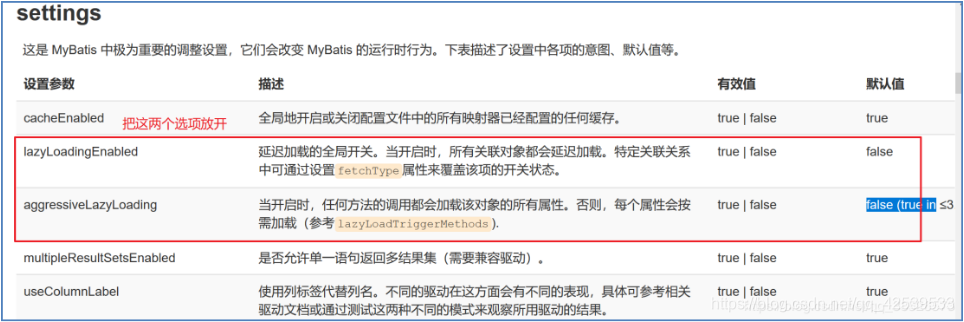
一对一的延迟加载
<settings>
<!-- 开启延迟加载 -->
<setting name="lazyLoadingEnabled" value="true"/>
<setting name="aggressiveLazyLoading" value="false"/>
</settings>

映射文件
EmpDao.xml
<?xml version="1.0" encoding="UTF-8"?>
<!DOCTYPE mapper
PUBLIC "-//mybatis.org//DTD Mapper 3.0//EN"
"http://mybatis.org/dtd/mybatis-3-mapper.dtd">
<mapper namespace="com.sxt.dao.EmpDao">
<resultMap type="Emp" id="baseResultMap">
<!-- 主表里面的信息 -->
<id column="empId" property="empId"/>
<result column="empName" property="empName"/>
<result column="sex" property="sex"/>
<!-- 配置1对1的关联关系 property 对应的就是Emp中部门成员变量的名称-->
<association property="dept" javaType="Dept"
column="deptId" select="queryDeptById">
<!-- 把deptId作为条件查询 queryDeptById-->
<id column="deptId" property="deptId"/>
<result column="deptName" property="deptName"/>
<result column="deptDesc" property="deptDesc"/>
</association>
</resultMap>
<select id="queryDeptById" parameterType="int" resultType="Dept">
select * from t_dept where deptId = #{deptId}
</select>
<select id="query" resultMap="baseResultMap">
select
t1.empId
,t1.empName
,t1.sex
,t1.deptId
from t_emp t1
</select>
</mapper>
测试
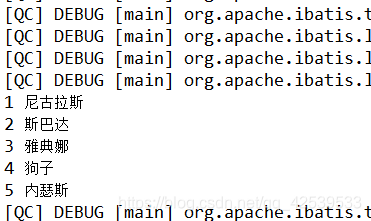



一对多
配置文件
开启延迟加载
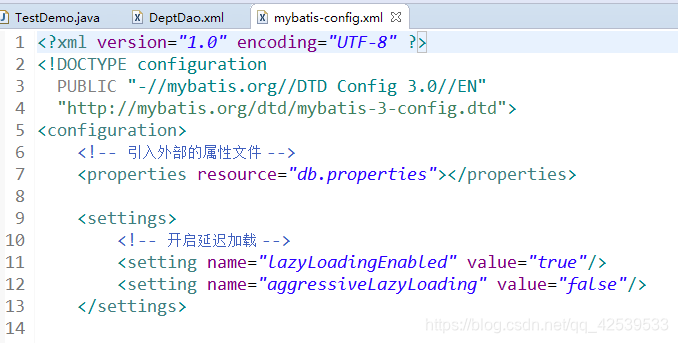
映射文件
<?xml version="1.0" encoding="UTF-8"?>
<!DOCTYPE mapper
PUBLIC "-//mybatis.org//DTD Mapper 3.0//EN"
"http://mybatis.org/dtd/mybatis-3-mapper.dtd">
<mapper namespace="com.sxt.dao.DeptDao">
<resultMap type="Dept" id="baseResultMap">
<!-- 主表里面的信息 -->
<id column="deptId" property="deptId"/>
<result column="deptName" property="deptName"/>
<result column="deptDesc" property="deptDesc"/>
<!-- 配置1对多的关联关系 ofType就是集合中泛型的类型-->
<collection property="emps" ofType="Emp" column="deptId" select="queryEmpByDeptId">
<id column="empId" property="empId"/>
<result column="empName" property="empName"/>
<result column="sex" property="sex"/>
</collection>
</resultMap>
<select id="queryEmpByDeptId" parameterType="int" resultType="Emp">
select * from t_emp where deptId = #{deptId}
</select>
<select id="query" resultMap="baseResultMap">
select
t1.deptId
,t1.deptName
,t1.deptDesc
from t_dept t1
</select>
</mapper>
要把tostring方法里的员工信息去掉
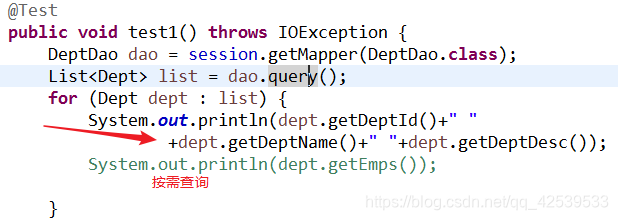














 本文详细探讨了MyBatis中的关联关系,包括1对1和一对多的映射配置、对象关系以及测试案例。同时,还介绍了延迟加载的概念,如何开启全局延迟加载,并展示了1对1和一对多延迟加载的映射文件和测试实践。
本文详细探讨了MyBatis中的关联关系,包括1对1和一对多的映射配置、对象关系以及测试案例。同时,还介绍了延迟加载的概念,如何开启全局延迟加载,并展示了1对1和一对多延迟加载的映射文件和测试实践。
















 8885
8885

 被折叠的 条评论
为什么被折叠?
被折叠的 条评论
为什么被折叠?








